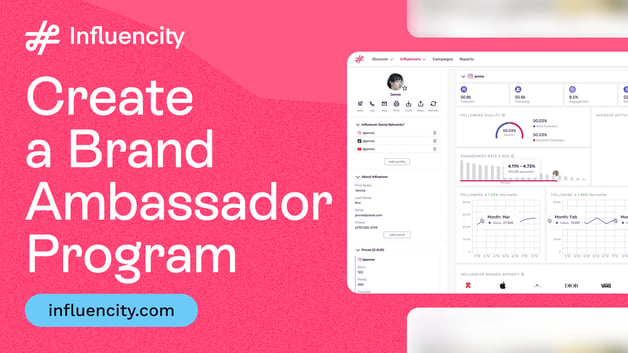Influencer Marketing Analytics: What Data Should You Measure?
Influencer marketing has become a powerful strategy for brands to connect with their target audience and promote their products or services. However, to effectively control and measure the success of your influencer marketing campaigns, you need to regularly gather and analyze various types of data.
This article explains the key influencer marketing analytics that brands should monitor to assess the performance of their influencer marketing campaigns. We will also offer insights on how to use this data to optimize your ongoing marketing strategies.
Why Are Influencer Marketing Analytics So Important?
Influencer marketing analytics are crucial for several reasons.
Firstly, influencer marketing analytics provide you with valuable influencer performance info that helps you measure the quality of influencer profiles and analyze their audience before you decide whether a collaboration would be worthwhile. This includes measuring an influencer's engagement rate, follower demographics, and content style. This information allows you to make informed decisions about which influencers align best with your brand and objectives.
Real-time performance data also provides you with measurable insights into the impact of your established influencer collaborations once you have launched a campaign, helping you assess the ROI and determine if your objectives are being met. For example, you can keep track of metrics like click-through rates, conversion rates, and impressions, allowing you to see how influencer-generated content resonates with your target audience in real-time.
Influencer marketing analytics are also essential for optimizing your content strategy. By identifying which content formats, topics, or creative approaches are garnering the most engagement and reach, you can refine your strategies for future campaigns, ensuring you deliver what your audience desires. Plus, this information allows you to understand who is engaging with your influencer's content. Metrics such as follower demographics, location, interests, and engagement patterns help ensure that the influencer's audience aligns with your brand's target market. Armed with this knowledge, you can tailor your content and messaging for maximum resonance.
Finally, compliance tracking is crucial in influencer marketing, and analytics play a pivotal role in this. They help you monitor whether influencers are adhering to legal and ethical guidelines regarding disclosure and transparency. Ensuring compliance not only protects your brand's reputation but also fosters trust with your audience.
What Influencer Marketing Analytics Should You Measure?
We are now going to explore the key influencer marketing analytics that you should be measuring on a regular basis when you launch a campaign. We will also discuss how you can use these insights to optimize your current and future campaigns for better engagement, reach, conversion, and overall performance.
The best way to track all this data so that you can boost your influencer marketing ROI is by using performance measurement tools such as those included in Influencity’s platform.
Engagement Rate
Definition: The ratio of likes, comments, and shares to the total number of followers on an influencer's post. Essentially, this influencer marketing analytic measures the level of interaction and interest in the content.
How to use this data for optimization: A high engagement rate indicates that the audience is actively interacting with content. You can optimize by selecting influencers who consistently have high engagement rates, and by encouraging influencers to create content that fosters engagement, such as asking questions or running contests.
Click-Through Rate (CTR)
Definition: The percentage of users who clicked on a link or CTA in the influencer's content, compared to the total number of users reached. This influencer marketing analytic indicates how effective the content is at driving traffic to your website or landing pages.
How to use this data for optimization: A low CTR may signal that the content or the call-to-action needs improvement. To optimize, you can experiment with different CTAs, content formats, and campaign types to increase the CTR and drive more traffic.
Conversion Rate
Definition: The percentage of users who completed a desired action (e.g., making a purchase, signing up for a newsletter) after clicking on the influencer's link. This influencer marketing analytic measures the ability of the content to drive conversions.
How to use this data for optimization: If the conversion rate is low, consider optimizing your campaign. Additionally, refine your influencer selection to target audiences more likely to convert based on historical data.
Follower Growth
Definition: The change in your brand's social media follower count during and after a campaign. This influencer marketing analytic reflects the campaign's impact on your target audience.
How to use this data for optimization: Monitor follower growth over time. If it decreases after a campaign, assess whether the influencer's audience aligns with your target market. Optimize by choosing influencers whose followers are more likely to become long-term customers.
Reach
Definition: The total number of unique users who have seen the influencer's content. This influencer marketing analytic measures a campaign's overall exposure.
How to use this data for optimization: High reach indicates broad exposure. To optimize this metric, select influencers with larger followings or collaborate with multiple influencers to increase your brand’s reach. You can also experiment with content that has the potential to go viral.
Impressions
Definition: The total number of times an influencer's content has been viewed, including multiple views by the same user. This influencer marketing analytic measures the overall visibility of your content.
How to use this data for optimization: If impressions are low compared to reach, it might indicate that the content is not being viewed multiple times. Optimize by creating more shareable content that encourages repeat views.
Audience Demographics
Definition: Data on the age, gender, location, interests, and other characteristics of an influencer's audience. This influencer marketing analytic is essential in the influencer research stage as it helps ensure alignment with your brand's target market.
How to use this data for optimization: Analyze audience demographics to tailor content and messaging to better resonate with your target audience. Optimize by selecting influencers whose followers match your ideal customer profiles.
Cost vs ROI
Definition: The total cost of the influencer marketing campaign compared to the return on your investment, typically in terms of revenue generated or leads acquired.
How to use this data for optimization: Calculate ROI to assess campaign profitability. To optimize, allocate your budget to the influencers and content types that deliver the best ROI and adjust spending accordingly.
Competitor Benchmarking
Definition: A comparison of your campaign's performance with similar campaigns run by your competitors, highlighting areas for improvement and competitive advantages.
How to use this data for optimization: Optimize by identifying gaps and opportunities in your strategy to gain a competitive edge.
Tags:






















%20and%20How%20Can%20They%20Benefit%20Your%20Brand%20article.jpg?length=628&name=What%20Are%20Key%20Opinion%20Leaders%20(KOL)%20and%20How%20Can%20They%20Benefit%20Your%20Brand%20article.jpg)








